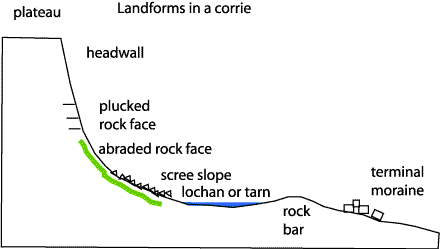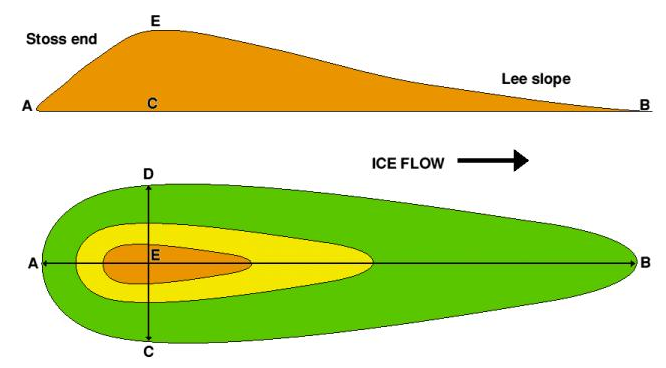Question
- Junior Cert. Geography (Higher) 2008: Section II Q2
- Back to the question >
Answer

One feature of glacial erosion is a Cirque or Corrie. They are the birth place of a glacier. An example is the Devil’s Punchbowl, Co Kerry. Snow collects in a hollow, usually on the north side of a slope. This snow remains during summer and starts to deepen. After some time the snow turns to ice at its base and starts to flow downhill. This ice picks up debris at the base of the glacier (plucking) and uses this debris to smooth its way downhill (abrasion). These processes are the processes of erosion. A semi-circular hollow is formed called a cirque/corrie. A lake can often develop in the corrie when the ice melts and this is called a tarn.
B.
A Drumlin is a feature of glacial deposition. It is a small hump-backed hill in the shape of an egg. Drumlins are found in Ireland between Clew Bay in the west and Strangford Lough in the east. When the ice retreated, it is thought that they formed below the ice. Drumlins have a steep stoss side (A) and a gentle lee side (B). The streamlined feature shows the direction of the ice and can be up to 30m tall and 1km long. The material in the drumlin is generally unsorted.

C.
(i) People have benefited from the results of glaciation as they have formed some of the most spectacular mountain features in the world. An example can be found in the Jungfrau region in Switzerland. Here the mountains have many features which owe themselves to glacial periods, e.g. the massive U-shaped valley of Lauterbrunnen. There are also many cirques/corries here. These attract tourists for hill walking, skiing and other sports to this area of spectacular scenery.
(ii) A disadvantage of the results of glaciation is that glaciers can block passages across mountain ranges. They can, therefore, be a barrier to communications. They are very dangerous to cross as they are covered with crevasses, for example those of the Valle Blanche in the Chamonix Valley, France.
